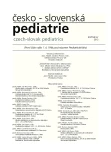Pyruvate kinase deficiency in children
Authors:
B. Ludíková 1; R. Mojzíková 2; P. Pospíšilová 2; J. Houda 1; L. Sulovská 1; M. Divoká 3; J. Hak 4; D. Procházková 5; V. Divoký 2; D. Pospíšilová 1
Authors place of work:
Dětská klinika Lékařské fakulty Univerzity Palackého a Fakultní nemocnice, Olomouc
přednosta prof. MUDr. V. Mihál, CSc.
1; Ústav biologie Lékařské fakulty Univerzity Palackého, Olomouc
ředitel doc. RNDr. V. Divoký, Ph. D.
2; Hemato-onkologická klinika Lékařské fakulty Univerzity Palackého a Fakultní nemocnice, Olomouc
přednosta prof. MUDr. K. Indrák, DrSc.
3; Dětská klinika Lékařské fakulty Univerzity Karlovy a Fakultní nemocnice, Hradec Králové
přednosta prof. MUDr. M. Bayer, CSc.
4; Dětské oddělení, Krajská zdravotní, a. s. – Masarykova nemocnice, Ústí nad Labem
primář MUDr. J. Škvor, CSc.
5
Published in the journal:
Čes-slov Pediat 2012; 67 (3): 152-159.
Category:
Původní práce
Summary
Purpose of the study:
Pyruvate kinase deficiency (PK) is the second most common enzymatic defect leading to hemolytic anemia. The aim is to demonstrate the clinical and laboratory findings in PK deficiency in the first pediatric patients in the Czech Republic who were defined at the molecular level.
Patients and methods:
Four children (10 months – 7 years) were examined for severe nonspherocytic hemolytic anemia with hemoglobin levels 64–97 g/l. All the children required transfusions and phototherapy after delivery, two of them even an exchange transfusion. The clinical finding was dominantly characterized by pallor, subicterus of sclerae and skin. Erythrocyte membrane disorder, hemoglobinopathies and congenital dyserythropoietic anemia were excluded using standard methods. PK activity was determined and sequencing of the gene encoding PK was done. Because of increased ferritin levels, hepcidin level was measured.
Results:
All children have macrocytic anemia with bilirubin values from 38 to 89 micromol/l. PK activity is decreased in all children (23–32%). Two patients are mixed heterozygotes for mutations c.1529C>A (p.Arg510Gln) and c.1594C>T (p.Arg532Trp) and one for the c.1493G>A (p.Arg498His) and c.1529C>A (p.Arg510Gln) mutations. In one case, a homozygous deletion in exon 11, which has not yet been described, was found. This patient with the most severe course of the disease has a high ferritin level, but a reduced level of hepcidin, which may contribute to iron overload. Coincidence with type I hemochromatosis was excluded.
Conclusion:
PK deficiency in the newborn may cause severe anemia and hyperbilirubinemia sometimes requiring an exchange transfusion and repeated administration of transfusions in infancy; their frequency is usually gradually reduced. PK deficiency may also be associated with iron overload and the need for chelation therapy. In the Czech population this disease is still underdiagnosed.
Key words:
glycolysis, pyruvate kinase, nonspherocytic hemolytic anemia, iron overload, hepcidin
Zdroje
1. Beutler E, Gelbart T. Estimation the prevalence of pyruvate kinase deficiency from the gene frequency in the general white population. Blood 2000; 95: 3585–3588.
2. Zanella A, Fermo E, Bianchi P, et al. Red cell pyruvate kinase deficiency: molecular and clinical aspects. Br J Hematol 2005; 130: 11–25.
3. Valentine WN,Tanaka KR, Miwa S. A specific erythrocyte gylcolytic enzyme defekt [pyruvate kinase] in free subjects with congenital non-spherocytic hemolytic anemia. Transactions of the Association of American Physicians 1961; 74: 100–110.
4. Satoh H, Tani K, Yoshida MC, et al. The human liver-type pyruvate kinase [PKL] gene is on chromosome 1 at band q21. Cytogenet Cell Genet 1988; 47: 132–133.
5. Takegawa S, Fuji H, Miwa S. Change of pyruvate kinase isozymes from M2- to L-type during development of the red cell. Br J Hematol 1983; 54: 467–474.
6. Tani K, Yoshida MC, Satoh H, et al. Human M2-type pyruvate kinase: cDNA cloning, chromosomal assignment and expression in hepatoma. Gene 1988; 20: 509–516.
7. Zanella A, Fermo E, Bianchi P, et al. Pyruvate kinase deficiency: The genotype-phenotype association. Blood Rev 2007; 21: 217–231.
8. Ferreira P, Morais L, Costa R, et al. Hydrops fetalis associated with erythrocyte pyruvate kinase deficiency. Eur J Pediatr 2000; 159: 481–482.
9. Tanaka KR, Zerez CR. Red cell enzymopathies of the glycolytic pathway. Semin Haematol 1990; 27: 165–185.
10. Tanphaichitr VS, Suvatte V, Issaragrisil S, et al. Successful bone marrow transplantation in a child with red blood cell pyruvate kinase deficiency. Bone Marrow Transplant 2000; 26: 689–690.
11. Lenzner C, Nurnberg P, Thiele BJ, et al. Mutations in the pyruvate kinase L gene in patients with hereditary hemolytic anemia. Blood 1994; 83: 2817–2822.
12. Beutler E, Blume KG, Kaplan JC, et al. International committee for standardization in haematology: recommended methods for red-cell enzyme analysis. Br J Haematol 1977; 35: 331–340.
13. Zanella A, Bianachi P, Iurlo A, et al. Iron status and HFE genotype in erytrocyte pyruvate kinase deficiency: Study of Italian cases. Blood Cells Mol Dis 2001; 27: 653–661.
14. Hilgard P, Gerken G. Liver cirrhosis as consequence of iron overload caused by hereditary nonspherocytic hemolytic anemia. World J Gastroenterol 2005; 11 (8): 1241–1244.
15. Viatte L, Vaulont S. Hepcidin, the iron watcher. Biochimie 2009; 91: 1223–1228.
16. Finkenstedt A, Bianchi P, Theurl I, et al. Regulation of iron metabolism through GDF15 and hepcidin in pyruvate kinase deficiency. Br J Haematol 2009; 144: 789–793.
Štítky
Neonatologie Pediatrie Praktické lékařství pro děti a dorostČlánek vyšel v časopise
Česko-slovenská pediatrie

2012 Číslo 3
- Horní limit denní dávky vitaminu D: Jaké množství je ještě bezpečné?
- Isoprinosin je bezpečný a účinný v léčbě pacientů s akutní respirační virovou infekcí
- Orální lichen planus v kostce: Jak v praxi na toto multifaktoriální onemocnění s různorodými symptomy?
Nejčtenější v tomto čísle
- Nedonošený novorozenec
- Neobvyklé manifestace infekce parvovirem B19 u dětí
- Poruchy vnitřního prostředí novorozenců
- Deficit pyruvátkinázy v dětském věku
